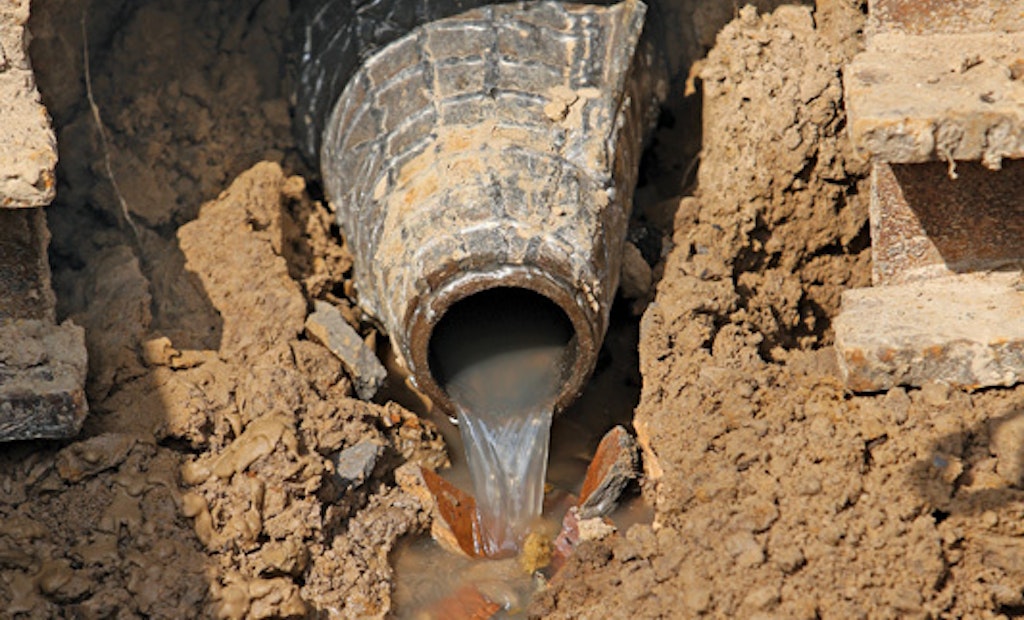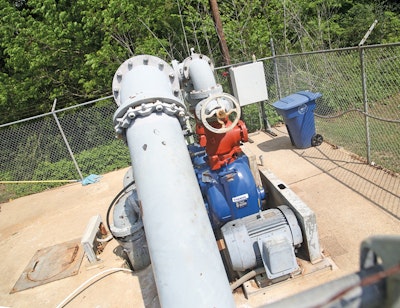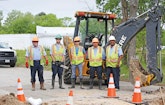
Interested in Infrastructure?
Get Infrastructure articles, news and videos right in your inbox! Sign up now.
Infrastructure + Get AlertsIf there’s an unofficial watchword for the Lufkin Department of Water and Sewer Utilities, it might be self-sufficiency.
The Texas utilities’ management culture emphasizes doing things in-house whenever possible. And while adhering to that ethic, the city has been pressing ahead with a comprehensive sewer system rehab program that has targeted a long-standing stormwater inflow and infiltration problem.
The I&I reduction effort has been underway for more than a decade, and won’t be finished until 2023. But the results are already apparent.
To date, the program has led to the repair or replacement of nearly 14 miles of sewer lines, with significantly more on the agenda before the deadline six years from now. And where the repairs have been completed, “We’re seeing next to zero stoppages,” says Jason Arnold, director of the utilities department. “When we’re seeing major rain events, those neighborhoods just aren’t having issues anymore.”
Located about 120 miles northeast of Houston in eastern Texas, Lufkin sees its population triple every working day.
“We’re a town with a population of a little over 35,000,” says Arnold. “But our daily population is well over 100,000. The number goes up during the day because we are surrounded by several small communities. People come here to work, shop, dine and do business. We’re also a major medical hub.”
A major meat processing plant uses lots of water — and generates plenty of wastewater at the other end.
With so much traffic on weekdays, doing whatever it takes to forestall emergency repairs becomes paramount. “It’s tough to fix a leak anywhere in town,” Arnold says. “It’s tough to dig up a sewage stoppage. We pride ourselves on taking care of problems and fixing them quickly.”
Overloaded
Lufkin’s I&I problems go back decades. “Around 72 percent of our sewer is clay tile pipe,” says Patrick Lynch, a water and sewer utilities department foreman for 27 years who has the day-to-day task of helping to carry out the subsequent rehab programs.
Clay tile pipe is notorious for its vulnerability to cracks and root penetration that contribute to I&I. “A couple of inches of rain would overload our sewer treatment plant,” Lynch says.
“The lines just couldn’t handle the flow. We’d have overflows in low-lying areas. Pretty much the whole system was overloaded — manhole covers were floating off.”
In the year 2000, Lufkin undertook an in-depth study tracking the impact of I&I-related overflows. With extensive smoke testing, the study also identified hot spots.
Many of the leaks showed up in the private portion of sewer laterals, and the city wrote to homeowners, informing them of their obligation under city codes to have repairs made. But the study also identified plenty of work needed on city-owned lines.
Setting priorities
In 2003, the city launched its sweeping 20-year repair and replacement program. The city was divided into five separate sectors that were ranked by priority. Work has finished on the two highest-priority sectors. Work on the third sector is underway now, and the lowest-priority fourth and fifth sectors will follow.
Projects have ranged from point repairs for localized leaks to complete replacement of sewer lines.
For full replacement, Lufkin has opted for pipe bursting where possible rather than open-trench replacement. “A lot of our lines are under roadways, so it’s more economical to do it by pipe bursting,” Lynch says.
For some bigger projects, such as a recent trunk line main replacement using 24-inch pipe, the city will turn to outside help. But for most of the work, “We try to do as much as we can in-house,” Lynch adds. “It’s easier for us to get material and to service our equipment.”
Lufkin uses Vermeer pipe bursting equipment — chosen because the company has a regional office less than 100 miles away as well as for the quality of its machinery. The new pipe going in is all PVC.
“We’ve become experts in the whole pipe bursting process,” Arnold says.
In more than a dozen years since the work started, Lynch has seen the equipment evolve. Where Lufkin once used an 8-ton winch to pull new pipe through the old, the city has upgraded to a 12-ton winch that allows for longer pulls — especially through the region’s unforgiving clay soil that hampered the smaller tool’s pulling capacity.
Venturing into lining
More recently, the city has begun using Perma-Liner cured-in-place products when that approach is feasible. So far, about 2,000 feet of CIPP lining has been completed. In keeping with its DIY ethic, the city has been training its own crews and acquiring the lining equipment rather than contracting out for that work. But it remains in the early stages. “We’re still perfecting the system,” Arnold says.
In choosing where to use pipe bursting and where to use lining, Lynch says it depends on the situation. Pipe bursting requires some localized excavation, such as where laterals connect to the mains. Since CIPP lining is an entirely no-dig system, it’s especially useful where lots of other utilities — waterlines and electrical conduits, for example — are close to each other.
For lining projects, the city is now aided by a TRY TEK Machine Works robotic cutter that it sends through the lines to trim up the material where there are pipe transitions. Arnold says the city also developed its own winch system to help pull the liner material through. The vehicle used for lining work has been supplied with modified refrigeration units to store the liner material.
“Where we’re still having to pipe burst are those areas where we’re not comfortable putting that cutter in the ground,” Arnold says. “And then there are areas that are so long it’s difficult to store [lining] stock that long or blow it in.” Longer stretches require precision that can be challenging, he notes. “The biggest we’ve done so far is 575 feet.”
But Lufkin is sold on the trenchless approach wherever it’s practical. “The benefits are pretty obvious,” Arnold says. “You’re saving a lot of time, you’re saving a lot of money. But most important, you’re not risking a trench accident.”
That’s a huge benefit. When a trench accident does occur, “it’s going to be a serious one,” he observes. “We want to get people out of those trenches every chance we get, and that’s what we’re working towards.”
Progress
The city has been happy with the outcome. “We can definitely see that we’re making progress on the problems,” says Lynch. “If you go through a spot where previously the sewer system was overflowing and where we have gone in and redone a section of it, you can see the system is able to handle it. Just knowing you’re making a dent in the problem gives us the motivation to keep moving forward.”
And members of the public have noticed, too. “They’ve acknowledged they know the work we’ve done is helping.”
Training employees to do the work and acquiring the necessary equipment has given the city greater flexibility, Arnold says. “Because we have the expertise, we do everything that we can ourselves.”
Doing the work in-house just makes problems easier to solve, the director explains. There are a lot fewer worries about who the city will have to call in an emergency or where the money is going to come from to hire a contractor to fix it.
“Rare is the construction project that we don’t do,” Arnold says. “We have a good engineering department. We have extremely qualified operators — guys who can really do just about everything, and looking at the whole scope of a job, can do it the best and the safest.” And the city’s manager, assistant manager, and city council “make sure we have the equipment we need.”
Keeping the work in-house also builds morale. “It changes the whole attitude,” Arnold says. “Our whole attitude is, there’s nothing we can’t take care of. Our guys take a lot of pride in not needing to call in contractors to do what we’re doing. They enjoy the fact that they’re given the tools and the people to do what they need to do.”
A new approach to lift station maintenance
The Lufkin Department of Water and Sewer Utilities has taken a proactive approach to lift-station maintenance and care. The aggressive preventive maintenance effort came about after Director Jason Arnold joined the Water and Sewer Utilities Department from Lufkin’s Parks and Recreation Department a couple of years ago.
“It seemed like every week we were having an emergency problem at a lift station,” Arnold says.
The utility was regularly spending $8,000 or more to make emergency pump repairs. Arnold knew there was a better way: Instead of waiting for trouble, manage it systematically by looking for it. “I got 100 percent support from my bosses,” he says.
The maintenance program has two parts. First, the lift station operator on duty visits each of the system’s 21 stations daily — checking on how many hours the pump has run in the last 24 hours, making sure no circuit breakers have been thrown, and opening the lid of the wet well to look for obvious signs of trouble.
Second, every six months, the lift station operator and the city electrician pull every lift station pump “whether we’re having a problem or not,” Arnold says. They put them on the inspection truck for a visual inspection for wear and tear, a pressure test, and a series of electrical tests.
“We’re checking whether they’re pulling too many amps, how many hours they’re running, and making sure the pumps are alternating properly,” Arnold explains. “We’re doing everything we can to prolong the life of the pumps that are running properly and identifying a potential hazard, and taking care of that pump before there’s an emergency problem.”
Such aggressive inspection isn’t cheap, at least in the short run. “When you look for problems, you find them,” Arnold acknow-ledges. “It’s costing a fair amount of money here. You’re finding pumps that need to be replaced — we’ve replaced quite a few more pumps this year than we would have preferred to do. We’ve made quite a few more repairs.”
But it’s also prevented much more costly and disruptive problems. Between the daily visits and the twice-yearly inspections, “We’ve found pumps that were hours away from getting burnt up,” Arnold says. “The only way we would have found them otherwise would have been a few hours later when it did burn up and the lift station was overflowing.”
And thanks to the proactive approach, those repairs now take place mostly on regular 8-5 workdays instead of being emergencies in the middle of the night or over the weekend. The program has practically eliminated the need for emergency repairs.
“We’ve saved thousands of dollars,” Arnold says. “We’re not sending guys out in the middle of the night, we’re not paying overtime, and we’re not putting them in a more dangerous situation.”








